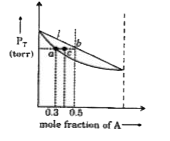Statement 1: Electrical conductivity of intrinsic semiconductors increases with increasing temperature.
Statement 2: With increase in temperature, large number of electrons from the valence band can jump to the conduction band.Solution in Malayalam
Statement 1 is True, statement 2 is true, statement 2 is correct explanation for statement 1.
Statement 1 is true, statement 2 is true, statement 2 is NOT a correct explanation for statement 1.
Statement 1 is true, statement 2 is false
Statement 1 is false, statement 2 is true
The correct Answer is:A
In case of semiconductors, the gap between valence band and the conduction band is small and therefore some of the electrons may jump from valence band to conduction band and thus on increasing temperature conductivity is also increased.
Topper's Solved these Questions
- BOOK - BRILLIANT PUBLICATIONCHAPTER - SOLID STATEEXERCISE - LEVEL-3 (Linked Comprehension Type)10videos
SOLID STATE
- BOOK - BRILLIANT PUBLICATIONCHAPTER - SOLID STATEEXERCISE - LEVEL-3 (Numerical Type)7videos
SOLID STATE
- BOOK - BRILLIANT PUBLICATIONCHAPTER - REDOX REACTION & ELECTROCHEMISTRYEXERCISE - QUESTION (ELECTROCHEMISTRY) (LEVEL -II) (ASSERTION-REASON)3videos
REDOX REACTION & ELECTROCHEMISTRY
- BOOK - BRILLIANT PUBLICATIONCHAPTER - SOLUTIONSEXERCISE - Level-III (Linked Comprehension Type)12videos
SOLUTIONS
Similar Questions
F centre is an example of metal excess defect due to the presence of extra cations at interstitial sites. Zinc oxide is white in colour at room temperature, on heating it loses oxygen and turns yellow.
ZnOHeat−−→Zn2++12O2+2e−
Now there is excess of zinc in the crystal and its formula becomes Zn1+x O. the excess of Zn2+ ions move to interstitial sites and the electrons to neighbouring interstitial sites.
There are many solids which are difficult to prepare in the stiochiometric composition and contain less amount of the metal as compared to stiochiometric proportion. a typical example of this type is FeO which is mostly found with a composition of Fe0.95. it may actually range from Fe0.96 O.
Q. In Fe0.95 O:02:16View SolutionDiamond structure is based on a face centred cubic lattice where four out of the eight tetrahedral holes are occupied by carbon atoms. Every atom in this structure is surrounded tetrahedrally by four other carbon atoms. How many carbon atoms per unit cell in diamond structure ?
02:08View SolutionAssertion: After the electrolysis of aqueous CuSO4 solution pH decreases.
Reason: Sulphuric acid is formed.02:13View Solution1 mole of A and 1 mole B are mixed together to form an ideal solution at 25∘C. Solution is placed in a vessel fitted with piston. If pressure on the solution is reduced isothermally.

Correct relationship between P∘AandP∘B is02:22View SolutionAssertion (A) : The electrical conductivity of a semiconductor increases with increase in temperature.
Reason (R ) : With increase in temperature, large number of electrons from the valence band can jump to the conduction band.01:34View SolutionWhat will be the probability of electrons to be found in the conduction band of an intrinsic conductor at a finite temperature with increasing band gap?
01:36View SolutionThe fraction (f) of the number of electrons raised from valence band to conduction band at temperature TK in intrinsic semiconductor is given by........
02:50View SolutionStatement 1: Conductivity of semiconductors decreases with increase in temperature
Statement-2: More electron goes from valance band to conduction band with increase in temperature.03:01View SolutionAssertion: The probability of electrons to be found in the conduction band of an intrinsic semiconductor at a finite temperature decrease exponentially with increasing band gap. Reason: It will be more difficult for the electron to cross over the large band gap while going from valence band to conduction band.
02:24View SolutionIf the temperature of semiconductor is increased the number of electrons in the valence band will
03:18View SolutionStatement I : Electrical conductivity of semiconductors increases with rise in temperature. Statement II : There is a small energy gap between conduction band and valence band.
02:54View SolutiondFku 1 : अर्द्धचालक की चालकता ताप में वृद्धि के साथ कम हो जाती है।
dFku 2 : ताप में वृद्धि के साथ अधिक इलेक्ट्रॉन संयोजी बैण्ड से चालन बैण्ड की ओर जाते है।View Solution(A) Electrical conductivity of semiconductors increases with increasing temperature. (R) With increase in temperature, large number of electrons from the valence band can jump to the conduction band
02:15View SolutionAssertion (A) : The electrical conductivity of a semiconductor increases with increase in temperature.
Reason (R ) : With increase in temperature, large number of electrons from the valence band can jump to the conduction band.03:01View SolutionAssertion: The probability of electrons to be found in the conduction band of an intrinsic semiconductor at a finite temperature decrease exponentially with increasing band gap.
Reason: It will be more difficult for the electron to cross over the large band gap while going from valence band to conduction band.04:45View Solution(A): While temperature of a semi conductor is increased its resistance decreases (R): The energy gap between conduction band and valency band is very small and on heating the electrons can be shifted from valence band to conduction band.
03:47View Solution

